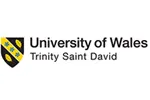

the United Kingdom
University of Wales Trinity Saint David| The award | How you will study | Study duration | Course start | Domestic course fees | International course fees |
|---|---|---|---|---|---|
| MDes | Full-time | 4 years | - | - | - |
| MDes | Part-time | 8 years | - | - | - |
Course Overview
Level 4
What we do in the first year is get the basic skills in place. There is an emphasis on typography, as we see this as a graphic designer's basic skill, no matter what field they eventually work in. We also aim to bring students up to speed in the basic software they need to use.
Structured private tutorials are introduced in the first year to ensure a positive student experience. The tutorials create an opportunity for staff to become aware of individual learning styles, learning difficulties, and diversity within the group.
Visual Studies is an important part of this, concentrating on ideas and creative thinking, and also having the flexibility to adapt to both cover new developments or to help reinforce areas covered in the core modules.
Level 5
If the first year was broadly about skills, the second year is broadly about becoming a professional designer. The core modules build on the areas covered in the first year, The briefs are longer and more challenging and we expect a more exploratory and intellectual approach to the students work than that of the first year. The Visual Studies continues with the theme of creative thinking. In the major project in the students devise and write their own brief(s) in negotiation with the staff, and this is seen as a stepping-stone to the third year.
Level 6
The third year is very student led, students negotiate their own briefs and deadlines. There are fewer formal lectures and more tutorial or seminar groups. Competitions and external work are undertaken and students can tailor their portfolios to the kind of job they want to do via self-generated projects. The staff encourage the students to take on substantial pieces of work, which will challenge them both intellectually and technically. The self-generated projects are there to allow the student creative freedom in the work, away from commercial constraints. The external projects do the opposite, the students work to live briefs, with the client imposing the usual commercial constraints on a designer.
There are a number of formative assessment points in the year, including two scheduled VIVA weeks for the third year, just before the Christmas and Easter breaks. These are invaluable, not only for the programme team to see and discuss the work, but also making the student stop and make a serious self-assessment of their work.
Level 7
Aims to nurture enterprising and sustainable practice in order for students to be at the forefront of the contemporary and future creative arts industry. The modules are designed to encourage advanced understanding of theoretical knowledge in research methods, entrepreneurial thinking and art and design practice. In particular, students studying at this level are encouraged to display resourcefulness, entrepreneurial skills, and the capacity to establish new and innovative ways of working.
Students progressing onto the Integrated Masters will be encouraged to expand upon their creative thinking. As with the MA Contemporary Dialogues - Visual Communication pathway, you will get the opportunity to blend your area of study with influences and experiences from other creative disciplines. This interaction between dialogues will help to expand your knowledge and broaden your creative practice that will in turn reflect into your major project work.
You will also build upon your personal design style that you will have nurtured in the first three years of the programme. Intensifying your own personal design flavor and readying yourself for the creative industries landscape.Key Features
Graphic Design is about designing effective visual communications. It is about the need to communicate something to individuals or to groups of people or organisations by graphic means. The graphic designer creates, manipulates and gives visual form to words and imagery in order to inform, persuade, delight - and occasionally disturb.
The programme provides you with a broad education in graphic design and, with an inbuilt degree of flexibility, it enables you to pursue individual interests whether in the fields of corporate graphics and brand identity, publishing, general design for print, packaging or interactive screen-based design.
Driven by industry standards and supported by state-of'the-art technologies, we produce highly employable graduates. Links with business and industry are an essential ingredient of the programme and are maintained and developed through 'live' projects,
Modules
Level 4
Level 5
Level 6
Level 7
International
Erasmus
During your time with us you will have the opportunity to study abroad with the Erasmus exchange programmes currently running with Universities in Norway, Barcelona and Sweden.
Study Abroad
Students can also take up the opportunity to study a semester in the USA and Canada.
For more information please click here.
Course Tutor(s)
Assessment
Formative assessment of project work takes place throughout the course in the form of frequent tutorials (both individual and group), seminars and critiques. This process is integral to the course and provides a continuous verbal commentary to the students on their practical work and associated research throughout the development of all of their projects.
Summative assessment in the form of visual portfolio, exhibition, research/ideas book/blog, or presentation is used at the end of each module to provide the students with a formal mark.
All assessment is based on 100% coursework. Students are expected to demonstrate their understanding in the form of practical project work. All practical work is project based.
Historical & Contextual Studies is also assessed on coursework in the form of essays and a dissertation at level 6.
Career Opportunities
The programme produces highly employable graduates, working in the creative industries, whether this be working in private practice, a design studio, a publishing house, a local authority, education, a museum, or charity or one of the newer digital industries. The professional opportunities for well-trained and educated graphic designers are broad and varied.
Further Information
The University provides many opportunities for students to take part in activities that will broaden their experiences and skills. Some are provided as part of the course; others are in addition to the programme of study. They all, however, enable our students to develop professional and personal skills.
The University has already embedded employability as a key feature of its academic provision but the University has also launched a new awards scheme as an additional opportunity for students to engage in activities that will allow them to further develop a wide range of employability skills.
? My time at Swansea was fantastic! Along with the great atmosphere, wonderful people and loads of resources I found the Uni had everything I could have wanted. My most important takeaway from the course was the preparation they give you to seamlessly enter the real world of design. Entering a large company didn't seem so daunting and I already understood most of the processes the business used, which along with an extensive knowledge of design was invaluable.'
Anna Jehan -Graphic Design Graduate
Art Director at Sapient Nitro, London
Related Courses
Additional Costs
Our students have access to a diverse range of equipment and resources, which in most cases are sufficient to complete their programme of study. We provide the basic materials necessary for students to develop their practical work within our extensive workshop and studio facilities. However, it is likely that art and design students will incur some additional costs to extend their investigation of their personal practice. For example, purchasing their own specialised materials and equipment, joining in optional study trips, and printing.
Entry Criteria
We are interested in creative people that demonstrate a strong commitment to art and/or design and therefore we welcome applications from individuals from a wide range of backgrounds. To assess student suitability for their chosen course we arrange interviews for all applicants at which your skills, achievements and life experience will be considered as well as your portfolio of work.
Our standard offer for a degree course is 120 UCAS tariff points. We expect applicants to have a grade C or above in English Language (or Welsh) at GCSE level, together with passes in another four subjects. Plus we accept a range of Level 3 qualifications including:
Qualifications are important, however our offers are not solely based on academic results. If you don't have the required UCAS points then please contact the courses admissions tutor or email [email protected] as we can consider offers to applicants based on individual merit, exceptional work, and/or practical experience.
See our Interview Guide for more information.
Below are some suggested courses at other providers that you may also be interested in:
Preparatory Courses in English for Degree Studies (Medical, Business, Architecture and Engineering, Psychology, English and American Studies) UG:Foundation, UG:Foundation, UG:Foundation
University of Pécs
Find out moreIf you do not meet the entry requirements for this course then consider one of these postgraduate preparation courses from another institution:
There are 501 other courses listed from University of Wales Trinity Saint David. A selection of these are displayed below:
Join the StudyLink email list and never miss a chance to turn your study abroad dreams into reality!

See other universities in Swansea
Find out more about studying in the United Kingdom